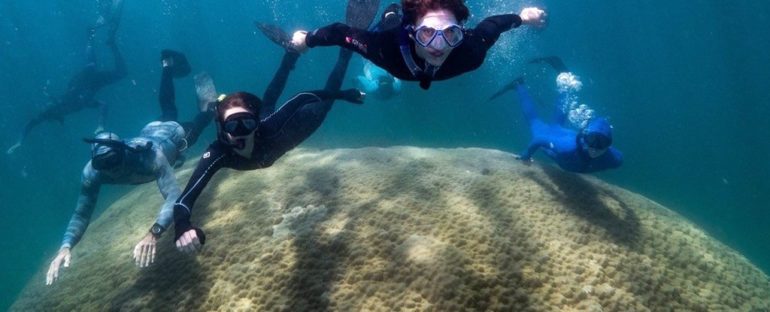Towering beneath sparkling waters off the coast of Australia’s Palm Islands is an ancient coral community that predates the European settlement of its neighboring continent.
This giant coral community has just been reported as the Great Barrier Reef’s widest coral, in fact – at an impressive 10.4 meters (34.1 ft) across.
Named Muga dhambi (Big Coral) by the traditional custodians of the Islands, the Manbarra people, this magnificent, thriving blob of latticed calcium carbonate is mostly inhabited by the colony of living coral polyps that constructed it over many generations.
“The large Porites coral at Goolboodi (Orpheus) Island is unusually rare and resilient,” James Cook University marine ecologist, Adam Smith, and colleagues write in their paper.
“It has survived coral bleaching, invasive species, cyclones, severely low tides, and human activities for almost 500 years.”
While the coral’s flanks are still home to its creators along with their algae symbiotes, zooxanthellate, part of its top is empty of them.
Instead, green boring sponge (Cliona viridis), algae and even other types of corals (Acropora and Montipora species) have taken up residence here – their competition for the remaining space drawing clear lines across the coral’s skeletal surface.
Muga dhambi and its inhabitants. (Smith et al., Scientific Reports, 2021)
These sponges are often found on the most turbulent side of corals, where they’re exposed to greater currents to facilitate their filtering of water for bacteria and other microbes to eat.
“The sponge’s advances will likely continue to compromise the colony size and health,” the researchers warn.
Sections of coral tissue can die from exposure to sun at low tides, or warm water, without killing the entire colony, Smith and team explain.
Under stress, upside-down-jellyfish-like coral polyps kick out their photosynthesizing zooxanthellae. This can allow them to conserve energy in the short term, but if the algae don’t return, the polyps soon die of starvation – this is what occurred to entire reefs during the recent devastating mass coral bleaching events.
The parts of the coral still living reflect the cumulative, intergenerational effect of beneficial and destructive environmental factors.

Discovered in March during a citizen science project, at a depth of 7.4 meters (24.3 ft) on a sandy reef slope, Muga dhambi is also the sixth tallest coral measured in the Great Barrier Reef, at 5.3 meters (17.4 ft) tall. Based on the colony’s height, the team estimates it to be between 421 and 438 years old.
They also found high-density ‘stress bands’ recorded in the coral’s structure, evident since 1877, that appear significantly more frequently in accordance with anthropogenic global warming.
But on reviewing significant environmental events since at least 1575, the researchers learnt this community of corals is mighty tough – having survived almost 100 bleaching events and up to 80 major cyclones during its lifetime, as well as declining water quality from sediment runoff.
Muga dhambi belongs to the genus of stony corals called Porites, along with 16 other species found on the Great Barrier Reef. They’re one of the most important types of reef-building corals – providing shelter with their large structures that other corals make use of.
Given the bleak future corals are facing, thanks to ocean acidification and anthropogenic global warming (mostly due to these 20 and these 100 companies), the researchers think we can learn a lot from monitoring this resilient colony.
The good news is that Smith and colleagues found no sign of disease or coral bleaching on Muga dhambi. For now, this amazing chonk of coral city is still teeming with life, with 70 percent of it inhabited by living coral.
If we take the actions recommended by scientists, there’s still a chance we can keep this ancient community alive for many more years to come.
This research was published in Scientific Reports.



